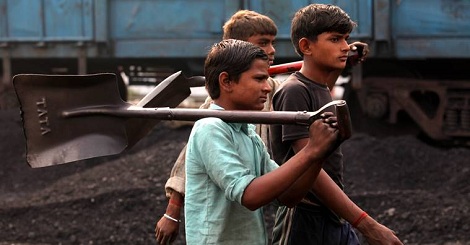The Lok Sabha passed the amendments to the Child Labour Act, there by laying a complete framework for the absolute prohibition of employment of children below the age of 14 but allowing minors to work in family enterprises. The Child Labour (Prohibition and Regulation) Amendment Bill, 2016 was finally passed in the Lok Sabha after a heated discussion.
Who is a Child Labour?
Child Labour is best defined as the utilization of the children in any kind of  work that strips that children of their childhood, interferes with their ability to attend regular school, and that is mentally, physically, socially or morally dangerous and harmful.
work that strips that children of their childhood, interferes with their ability to attend regular school, and that is mentally, physically, socially or morally dangerous and harmful.
A variety of Indian social scientists as well as the Non-Governmental Organization (NGOs) have done extensive research on the numeric figures of child labor in India and pathetically determined that India contributes to one-third of Asia’s child labor and one-fourth of the world’s child labor.
What is Child Labor law?
Child Labor Law which has been amended 2012 mainly focus to ban employment of children under 14 years in all kinds of commercial enterprises. The original Child Labor Prohibition Act of 1986 banned employment of children below 14 in only 18 hazardous industries.
The Bill passed with drastically cuts down on the number of industries that are considered hazardous for children, from 83 to just 3, effectively knocking off zari work, bangle-making, garment industry, leather and tanneries among others in the list.
The amended Child Labour Act prohibits the employment of children (below 14 years of age) in all occupations except in non-hazardous family enterprises or the entertainment industry.
Opposition for this bill:-
BJP MP Varun Gandhi expressed his condemn that It is as a form of slavery, not skill training. India has the largest number of child laborers in the world and RK Ray of the BJP added that more children being forced to work is another problem that can be blamed on over-population.
Drawbacks of this bill:-
But, Children’s rights activist and Nobel laureate Kailash Satyarthi also expressed his displeasure and concern regarding the bill that “There is a thin line between family enterprise and employers. In the past, there have been many instances where employers have claimed to be the fathers, uncles or children, sometimes of up to 30 children. Now, they will have legal backing”
The amended Child Labor Bill might give the first impression that the government is taking a stringent measure to end child labor.
The government has made the amendments based on the premise that education and work for children can go hand in hand, but this defeats the very purpose of protecting children from exploitation.
According to the statistics made available by CRY, only 33 out of 100 children are completing Class 12. The amendments to the Child Labor Act make the situation grimmer




